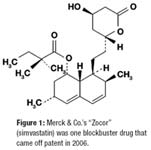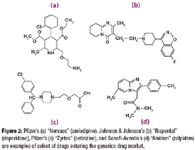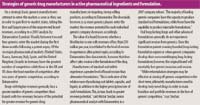Favorable Outlook for Generic APIs
A spate of drugs are scheduled to come off patent, offering vast potential and competition.
The near and long-term outlook for generic drugs is robust, creating both opportunities and challenges for generic drug manufacturers and suppliers of active pharmaceutical ingredients (APIs) to the generic drug industry. While industry fundamentals are strong, so is competition following a recent round of consolidation among generic drug manufacturers and their continued positioning in offshore production and development facilities.
Growth projections are sound
Industry estimates point to strong growth for generic drugs. In 2006, products with sales in excess of $18 billion lost their patent protection in seven key markets, including the United States, which represents more than $14 billion of those sales, according to IMS Health (Norwalk, CT). In 2006, prescription volume of unbranded generics grew by 13%, and sales of unbranded generics grew by 22%.
"Last year, we saw two of the most successful and largest brands, Zoloft and Zocor, lose patent protection," said Diana Conmy, corporate director of IMS Market Insights, in a March 2007 IMS press release. "Although the impact to the market was moderate, competitive pricing in generics is expected to intensify. We expect to see the full effect of these patent expirations, as well as that of additional branded blockbuster drugs such as 'Norvasc' and 'Ambien' impact the market in 2007."

Figure 1
Several top-selling drugs either lost US patent protection in 2006 or will in 2007 (see Figures 1 and 2). Merck & Co. Inc.'s (Whitehouse Station, NJ) "Zocor" (simvastatin) lost US patent protection in 2006, and the patent for Sanofi-Aventis's and Bristol-Myers Squibb's (New York) "Plavix"(clopidogel) was challenged. In 2007, Pfizer's (New York) "Norvasc" (amlodipine) and "Risperdal" (risperidone) by Johnson & Johnson's New Brunswick, NJ) subsidiary Janssen LP will lose patent protection (1).

Figure 2
In addition to Zocor, Norvasc, and Risperdal, other key drugs recently came off patent or are slated to come off patent. In 2006, key drugs that came off patent included Pfizer's "Zoloft" (sertraline), Boehringer Ingelheim's (Ingelheim, Germany) "Mobic" (meloxicam), Bristol-Myers Squibb's "Pravachol" (pravastatin), and GlaxoSmithKline's (GSK, London) "Zofran" (ondansetron) and "Flonase" (fluticasone).
In 2007, key drugs coming off patent are Pfizer's "Zyrtec" (cetirizine), Sanofi-Aventis's "Ambien" (zolpidem), and GSK's "Coreg" (carvedilol). (1).
Overall, during 2006–2010, drugs with a value of roughly $62 billion are expected to come off patent, according to estimates from Lehman Brothers (2). This level represents sizeable increases from recent four-year periods when approximately $35 billion of drugs came off patent during 2001–2005 and approximately $15 billion during 1996–2000 (2). And growth in the generics market is expected to continue as drugs worth nearly $140 billion in sales (based on 2005 sales estimates) are coming off patent by 2016, according to Datamonitor PLC (London).
Demand for generic APIs surges
The growth in generics drugs is reflected in the growth for APIs to the generic drug industry. In 2005, generic APIs accounted for 43.5% (or $13.5 billion) of the total merchant API market (including both APIs and advanced intermediates), according to the Chemical Pharmaceutical Generic Association (CPA, Milan, Italy). Branded or innovative APIs accounted for 56.5% or $17.5 billion (1).
Global demand for APIs as a whole (both branded or innovative and generic APIs) is expected to increase at an average annual rate of 8.2% over the next several years, according to CPA. The merchant market for APIs is expected to reach $46 billion by 2010, with demand for generic APIs growing faster than demand for APIs for branded or innovative drugs. Demand for generic APIs is projected to increase at an annual average rate of 10.9% to reach $22.7 billion by 2010. In contrast, demand for APIs for branded or innovative drugs is forecast to increase at an annual average rate of 5.9% to reach $23.3 billion by 2010. This differential in growth rates will shift the balance of API power to near parity by 2010 with generic APIs at 49.4% and branded or innovative APIs at 50.6%, according to CPA (1).

Strategies of generic drug manufacturers in active pharmaceutical ingredients and formulation.
In the US, demand for merchant generic APIs was $3.2 billion in 2005. By 2010, this level is projected to increase to $4.7 billion, according to CPA (1).
Generic formulators position in APIs
The combination of strong growth for generics, combined with increased competition, is leading several major generic drug makers to consolidate and to establish low-cost API production sites offshore.
Mylan Laboratories. In the most recent move, Mylan Laboratories (Canonsburg, PA) announced in May 2007 that it was acquiring the generics business of Merck KGaA (Darmstadt, Germany) for EUR 4.9 billion ($6.7 billion), in a deal that is expected to close in the second half of 2007. The combined company will have 2006 pro forma sales of approximately $4.2 billion. This move follows Mylan's 2007 purchase of a controlling interest in Matrix Laboratories (Hyderabad, India). With the acquisition of Matrix, Mylan is able to backward integrate its finished-dosage form capabilities with Matrix's API manufacturing and drug-development activities.
Matrix is the world's second largest API player based on number of drug master files, according to the company, with over 165 APIs in the market or under development based on 2006 estimates. Matrix has 10 API and pharmaceutical intermediate manufacturing facilities and one finished-dosage manufacturing facility, of which seven are approved by the US Food and Drug Administration (Rockville, MD), according to Mylan.
Actavis Actavis. (Hafnarfjordur, Iceland) considered, but withdrew, from the race to acquire Merck KGaA's generic business. At press time, Actavis was considering an offer to take the firm private by Novator (Reykjavik, Iceland), an investment firm led by Bjorgolfur Thor Bjorgolfsson, chairman of Actavis.
During 2006–2007, Actavis made several moves to augment its generics business, including strengthening its offshore manufacturing capabilities. It acquired Abrika Pharmaceuticals Inc. (Fort Lauderdale, FL), a specialty generic pharmaceuticals company; expanded its presence in Russia with the purchase of a majority stake in the pharmaceutical manufacturer ZiO Zdorovje (Podolsk, Russia); acquired a manufacturing plant from Grandix Pharmaceuticals, a manufacturing and marketing company based in Chennai, India; and acquired the API division of Sanmar Specialty Chemical in Chennai. Actavis also opened a new API development unit in India, which allows the company to backward integrate its business. Actavis hopes to develop 10–15 products per year at its new API development center.
Teva Pharmaceutical. In 2006, Teva Pharmaceutical Industries (Petach Tikva, Israel) acquired the generic drug manufacturer Ivax Corporation. The move followed Teva's acquisition of Sicor in 2004. In addition to building Teva's position in generic drugs, these moves also enhanced Teva's position in APIs. Teva gained 30 additional APIs with the Ivax acquisition. Teva operates 18 API manufacturing sites and offers approximately 250 different APIs. In 2006, approximately 56% of the sales from Teva's API business provided APIs for Teva's generic drugs, and the balance was to third-party businesses.
Teva's API division has expertise in specialized technologies, such as fermentation processes, high-potency APIs, and peptide-based APIs. The company says these capabilities enabled its API division to support launches of pravastatin and simvastatin in the US in 2006 and to establish a position in the sale of fermentation products such as lovastatin, simvastatin, pravastatin and tobramycin.
Watson Pharmaceuticals. Watson Pharmaceuticals (Corona, CA), which acquired Andrx Corporation (Miami, FL) for roughly $1.9 billion in 2006, is also leveraging offshore manufacturing assets in its generics business.
During 2006, Watson continued its generic product-development alliance with Cipla Ltd. (Mumbia, India). Under the terms of the agreement, Watson is responsible for conducting bioequivalence studies, pursuing regulatory approvals for all developed products, and has exclusive US marketing rights for the products. Cipla is responsible for development and manufacturing of products.
In 2006, Watson acquired Sekhsaria Chemicals, Ltd. (Mumbai, India), which provides API and finished-dosage formulation expertise. Watson also increased its investment in Scinopharm Taiwan, Ltd. (Shan-Hua, Taiwan), a company specializing in the development and manufacture of APIs. In December 2005, Watson acquired a solid-dosage manufacturing facility in Goa, India.
Barr Laboratories. Barr Laboratories (Woodcliff Lake, NJ) acquired Pliva (Zagreb, Croatia) for approximately $2.4 billion in 2006, which positions the company in European markets and also provides it with low-cost production and research and development (R&D) facilities. With the Pliva acquisition, Barr acquired a bio-study R&D center in Goa, India, and gained access to manufacturing capabilities in Croatia, Poland, and the Czech Republic. Croatia is the site of Barr's European operations headquarters, where it has manufacturing, R&D, biopharmaceutical, and API facilities. The company also has R&D and manufacturing facilities in Poland and the Czech Republic.
API import issues emerge
As the supply lines for generic APIs extend offshore, particularly to India and China, certain industry groups are raising concerns over the level of inspections at foreign manufacturing facilities. Last fall, the Synthetic Organic Chemical Manufacturers Association (SOCMA, Washington, DC) and the European Fine Chemicals Group (EFCG, Brussels) teamed up to urge US and European regulatory authorities to increase inspections of foreign manufacturing facilities of APIs (3). Joseph Acker, president of SOCMA, and Guy Villax, chairman of EFCG's Pharmaceuticals Business Committee, commented on key issues in a joint press release last October.
The move followed the submission of a citizen petition to FDA by SOCMA's Bulk Pharmaceuticals Task Force, asking the agency to increase inspections of drug-manufacturing facilities located outside of the US (3). SOCMA is the US trade association representing chemical batch and custom manufacturers.
The EFCG has taken an active role in raising concerns over the preparedness of European Union (EU) and European national regulatory authorities in implementing recent EU legislation that requires all medicines marketed in the EU be made with APIs that comply with harmonized good manufacturing practices by the International Conference on Harmonization. EFCG had drawn attention to the need for increasing resources for foreign inspection and improving enforcement measures by EU and national authorities (4, 5). EFCG was formed in 2004 to address the growth and competitiveness of European fine-chemical companies and is part of the European Chemical Industry Council (Brussels) (5).
The SOCMA-EFCG statement specified that the level of foreign inspections has not kept pace with changing API supply patterns. In 2005, the associations specified that FDA conducted 163 inspections of foreign API manufacturers, of which 14 (9%) were in China and 23 (14%) were in India, which was not proportional to the quantity of APIs being imported (3).
A similar concern exists in the EU, where the European Directorate for the Quality of Medicines inspected about 80 API manufacturing sites during a seven-year period, with roughly half of those inspections in China and India (3).
References
1. P. Van Arnum, "The Changing Fortunes of APIs," Pharm. Technol. 31 (1), 52–58, 2007.
2. R. Silver, "A Wall Street Perspective on Generics," Generic Pharmaceutical Association Annual Meeting, Phoenix, AZ, Mar. 1–3, 2007.
3. "Uneven Enforcement Leads to Sub-par Drugs and National Security Risk," European Fine Chemicals Group (EFCG, Brussels, Belgium) and the Synthetic Organic Chemical Manufacturers Association (SOCMA, Washington, DC), Aug. 22, 2006.
4. G. Villax and C.Oldenhof, "Global API Sourcing: What is Next for Suppliers to the European Union," Pharm. Technol. Sourcing and Management 2 (7), e10–e19 (2006).
5 P. Van Arnum, "EFCG Looks to Add Muscle to New EU Directive on APIs," Pharm. Technol. Sourcing and Management 2 (3), e14–e20 (2007).

Drug Solutions Podcast: A Closer Look at mRNA in Oncology and Vaccines
April 30th 2024In this episode fo the Drug Solutions Podcast, etherna’s vice-president of Technology and Innovation, Stefaan De Koker, discusses the merits and challenges of using mRNA as the foundation for therapeutics in oncology as well as for vaccines.
Drug Solutions Podcast: Applying Appropriate Analytics to Drug Development
March 26th 2024In this episode of the Drug Solutions Podcast, Jan Bekker, Vice President of Business Development, Commercial and Technical Operations at BioCina, discusses the latest analytical tools and their applications in the drug development market.